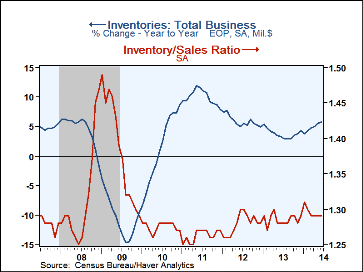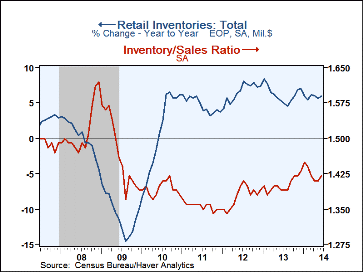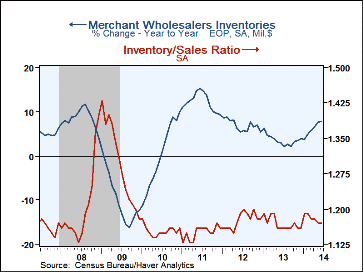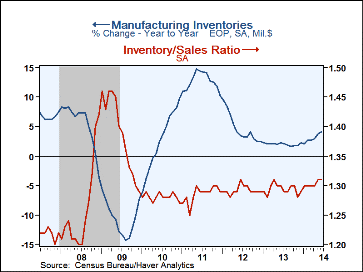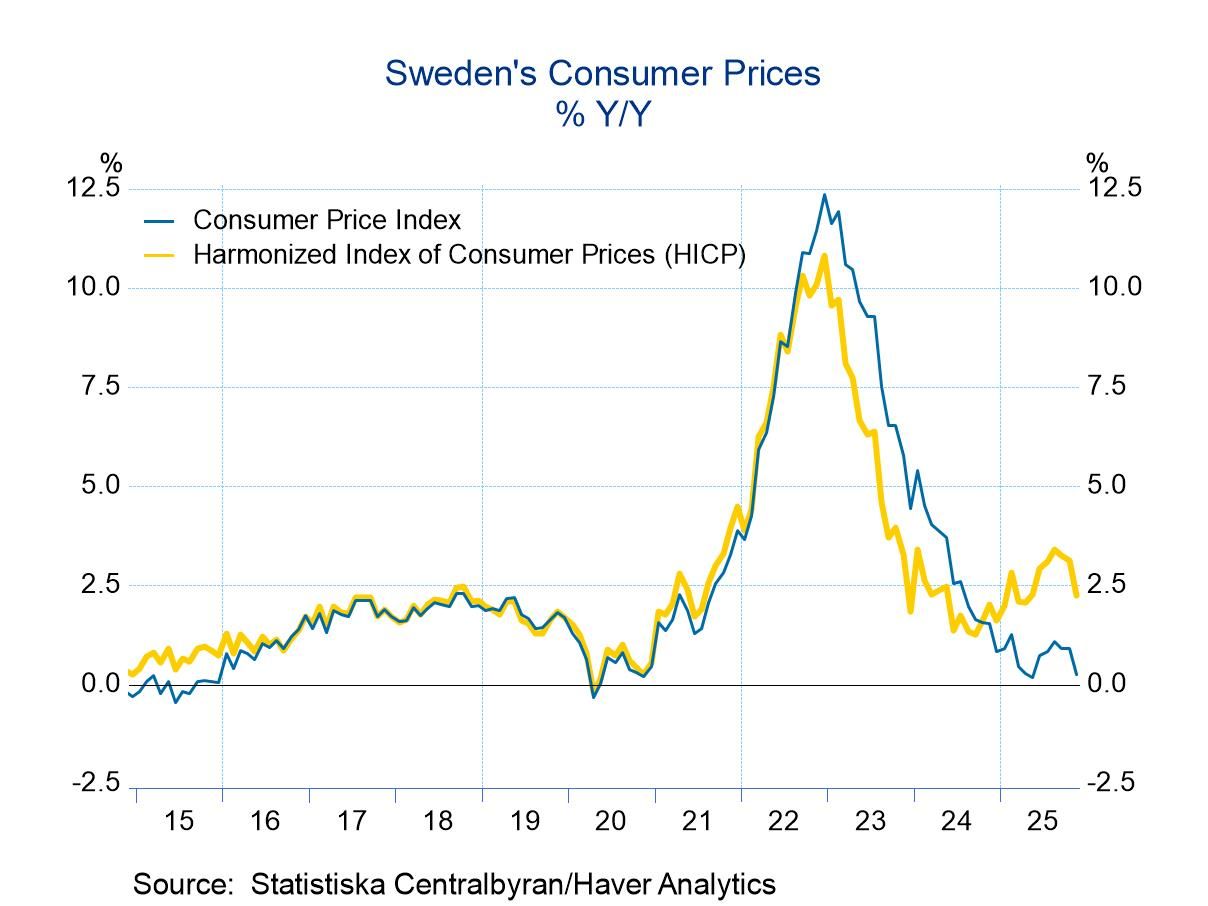 Global| Aug 13 2014
Global| Aug 13 2014U.S. Business Inventories and Sales Continue Upward
by:Tom Moeller
|in:Economy in Brief
Summary
Total business inventories increased 0.4% in June (5.8% y/y) after an unrevised 0.5% May advance. Increases in inventories during Q2'14 picked up versus the first quarter and added 1.6 percentage points to real GDP growth. That [...]
Total business inventories increased 0.4% in June (5.8% y/y) after an unrevised 0.5% May advance. Increases in inventories during Q2'14 picked up versus the first quarter and added 1.6 percentage points to real GDP growth. That followed subtractions during the prior two quarters.
Retail inventories increased 0.5% (5.9% y/y) after a 0.2% May rise. Auto inventories continued firm, rising 0.9% (10.9% y/y). Nonauto inventories increased 0.3% (3.7% y/y), the firmest gain since February. Furniture, electronics & appliances inventories rebounded 0.6% (6.1% y/y) and building materials inventories rose 0.5% (2.3% y/y). Inventories at clothing & accessory stores ticked 0.1% higher (2.5% y/y) and general merchandise store inventories gained 0.2% (3.2% y/y). Food & beverage store inventories were unchanged (2.6% y/y).
Factory sector inventories gained 0.3% (4.0% y/y) reflecting a 0.4% increase (5.8% y/y) in durables and a 0.1% uptick (1.4% y/y) in nondurables. The 0.3% advance (7.9% y/y) in wholesale inventories reflected a 0.7% gain (8.8% y/y) in durables. Nondurables inventories fell 0.2% (+6.4% y/y), down for the second straight month.
The latest inventory gains were accompanied by another 0.3% increase (4.6% y/y) in business sales. Merchant wholesale sales gained 0.2% (6.5% y/y). Retail sales increased a lessened 0.2% (4.0% y/y) and excluding autos sales gained 0.4% (3.3% y/y). Shipments from the factory sector recovered 0.5% (3.8% y/y).
The overall inventory-to-sales ratio remained steady at 1.29, down a bit from the 1.31 January high. The I/S ratio in the wholesale sector was unchanged at 1.17 and in the factory sector it held at 1.31. In the retail sector, the inventory-to-sales ratio ticked up to 1.42 while the nonauto retail ratio remained at 1.22.
The manufacturing and trade data are in Haver's USECON database.
| Manufacturing & Trade (%) | Jun | May | Apr | Jun Y/Y | 2013 | 2012 | 2011 |
|---|---|---|---|---|---|---|---|
| Business Inventories | 0.4 | 0.5 | 0.6 | 5.8 | 4.3 | 4.9 | 7.9 |
| Retail | 0.5 | 0.2 | 0.5 | 5.9 | 7.1 | 7.4 | 3.7 |
| Retail excl. Motor Vehicles | 0.3 | 0.0 | 0.1 | 3.7 | 3.8 | 3.2 | 3.5 |
| Merchant Wholesalers | 0.3 | 0.3 | 1.0 | 7.9 | 4.0 | 5.5 | 9.2 |
| Manufacturing | 0.3 | 0.8 | 0.5 | 4.0 | 2.3 | 2.4 | 10.2 |
| Business Sales (%) | |||||||
| Total | 0.3 | 0.3 | 0.8 | 4.7 | 3.4 | 4.5 | 10.9 |
| Retail | 0.2 | 0.4 | 0.7 | 4.0 | 4.3 | 5.0 | 7.7 |
| Retail excl. Motor Vehicles | 0.4 | 0.3 | 0.7 | 2.7 | 3.0 | 4.0 | 7.1 |
| Merchant Wholesalers | 0.2 | 0.7 | 1.3 | 6.5 | 4.3 | 4.8 | 12.4 |
| Manufacturing | 0.5 | -0.1 | 0.4 | 3.8 | 2.0 | 4.0 | 12.1 |
| I/S Ratio | |||||||
| Total | 1.29 | 1.29 | 1.29 | 1.28 | 1.28 | 1.28 | 1.26 |
| Retail | 1.42 | 1.41 | 1.41 | 1.39 | 1.40 | 1.38 | 1.36 |
| Retail Excl. Motor Vehicles | 1.22 | 1.22 | 1.23 | 1.22 | 1.22 | 1.21 | 1.23 |
| Merchant Wholesalers | 1.17 | 1.17 | 1.18 | 1.16 | 1.17 | 1.18 | 1.15 |
| Manufacturing | 1.31 | 1.31 | 1.30 | 1.30 | 1.29 | 1.29 | 1.29 |
Tom Moeller
AuthorMore in Author Profile »Prior to joining Haver Analytics in 2000, Mr. Moeller worked as the Economist at Chancellor Capital Management from 1985 to 1999. There, he developed comprehensive economic forecasts and interpreted economic data for equity and fixed income portfolio managers. Also at Chancellor, Mr. Moeller worked as an equity analyst and was responsible for researching and rating companies in the economically sensitive automobile and housing industries for investment in Chancellor’s equity portfolio. Prior to joining Chancellor, Mr. Moeller was an Economist at Citibank from 1979 to 1984. He also analyzed pricing behavior in the metals industry for the Council on Wage and Price Stability in Washington, D.C. In 1999, Mr. Moeller received the award for most accurate forecast from the Forecasters' Club of New York. From 1990 to 1992 he was President of the New York Association for Business Economists. Mr. Moeller earned an M.B.A. in Finance from Fordham University, where he graduated in 1987. He holds a Bachelor of Arts in Economics from George Washington University.


